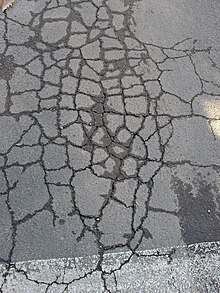Crocodile cracking
Fatigue cracking is an asphalt pavement distress most often instigated by failure of the surface due to traffic loading.
However, fatigue cracking can be greatly influenced by environmental and other effects while traffic loading remains the direct cause.
Frequently, overloading happens because the base or subbase inadequately support the surface layer and subsequently cannot handle loads that it would normally endure.
[1] A heavy spring thaw, similarly to poor drainage, can weaken the base course, leading to fatigue cracking.
[1] This can cause fatigue cracking to develop rapidly, as overloading will happen with loads of less magnitude or frequency.
[3] It is caused by lack of support of the road edge, sometimes due to poorly drained or weak shoulders.
[4] There are many different ways to measure fatigue cracking, but in general a pavement distress manual or index will be used.
Systems have been developed that detect fatigue cracking and other types of pavement distress automatically.
For example, reducing overloading on an asphalt pavement or improving drainage[2] can prevent fatigue cracking in many cases.
A good strategy to prevent overloading, which is a main cause of fatigue cracking, is to increase the depth of the asphalt layer.
According to certain researchers, pavements that exceed a certain minimum strength or thickness can hypothetically handle infinitely many loads without showing structural defects, including fatigue cracking.
When repairing pavement affected by fatigue cracking, the main cause of the distress should be determined.
